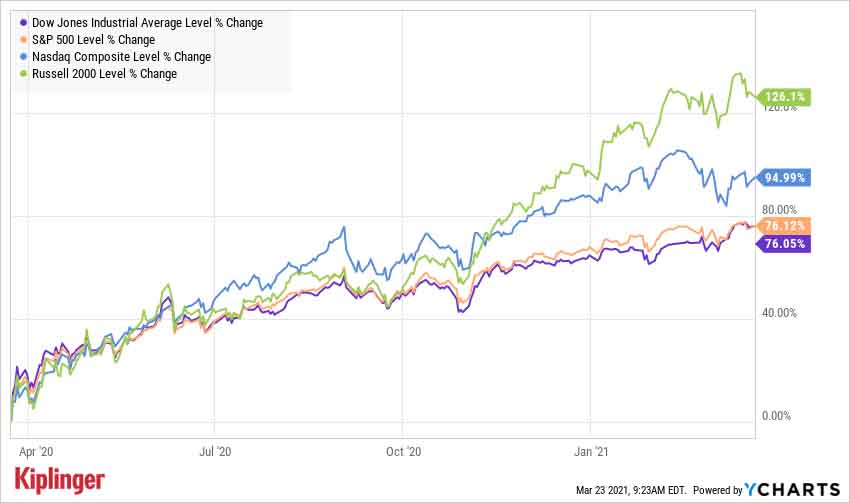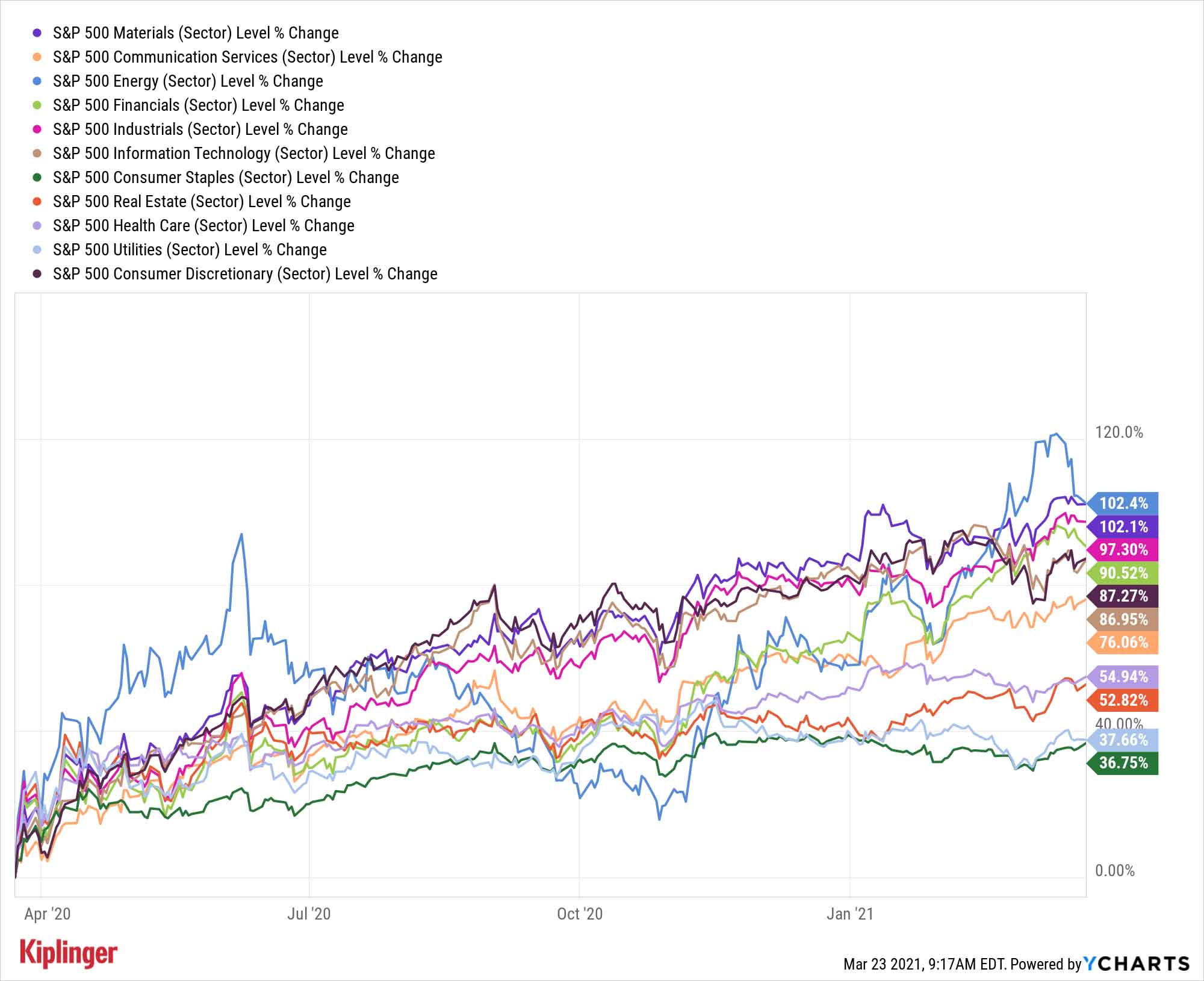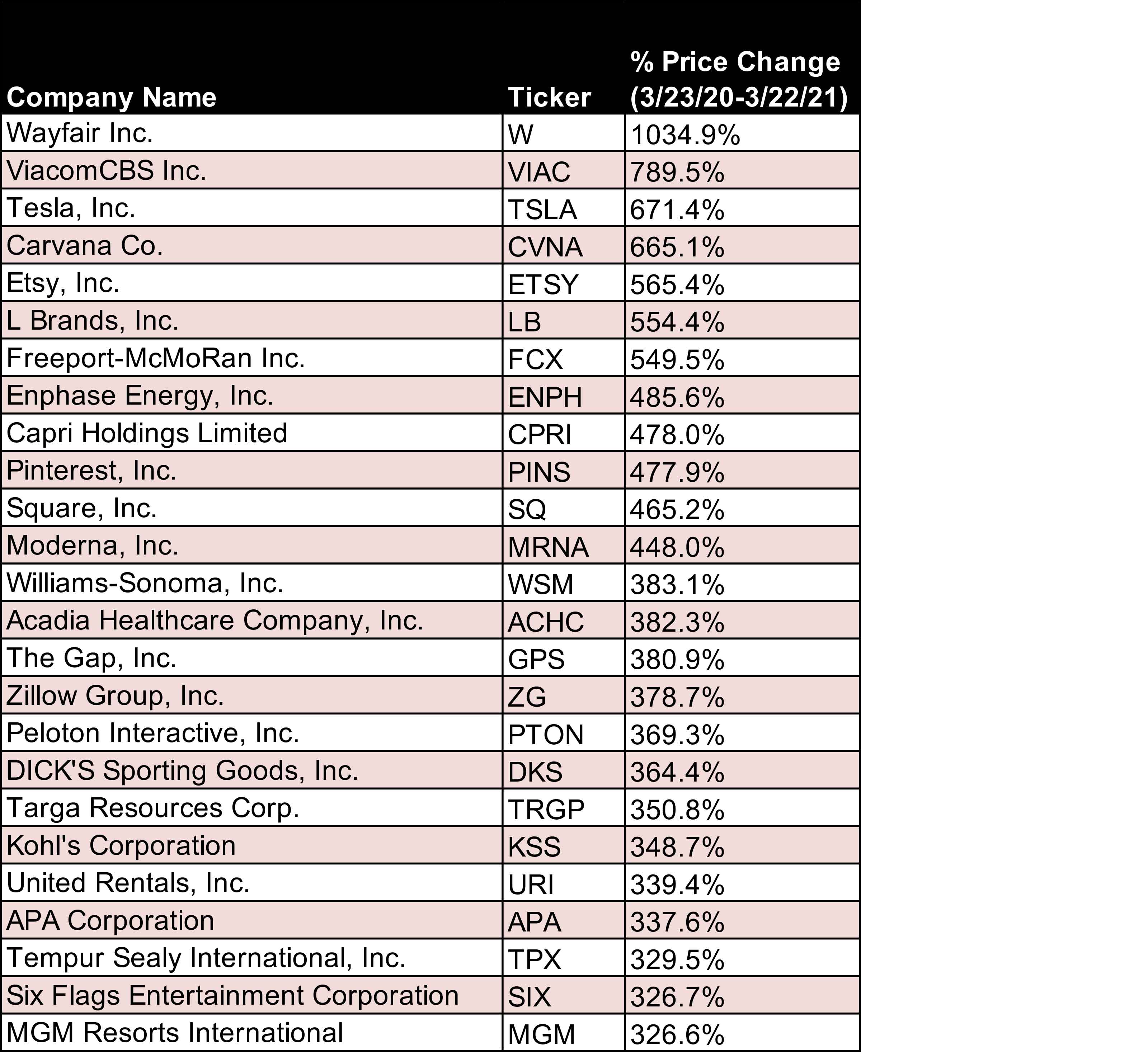The 25 Best Stocks Since the COVID Bear Market Bottom
Top performers one year after the end of the COVID crash range from names that thrived during lockdowns to more speculative bets on a gradual return to pre-pandemic normal.


The fastest crash in U.S. market history bottomed out a year ago today. And as dizzying as the 2020 bear market descent was at the time, the ensuing bull market has been almost as unthinkable, with dozens of stocks more than tripling over the past 52 weeks.
Between its pre-crash closing peak on Feb. 19 and its closing bottom on March 23, the S&P 500 lost 34%. Never before had stocks fallen so far so fast – not even during the Great Financial Crisis or the Great Depression.
There was, of course, no way to know at the time. But on March 23, the bear market ended almost as quickly as it started.

Sign up for Kiplinger’s Free E-Newsletters
Profit and prosper with the best of expert advice on investing, taxes, retirement, personal finance and more - straight to your e-mail.
Profit and prosper with the best of expert advice - straight to your e-mail.
The S&P 500 is up a little more than 76% since then. The Dow Jones Industrial Average has likewise tacked on roughly 76% and recently topped 33,000 for the first time. The tech-heavy Nasdaq Composite, meanwhile, is up a whopping 95%, even after stumbling in the early months of 2021.
And as for the small-cap benchmark Russell 2000? Forget about it. Stocks with smaller market values are supposed to outperform in the early days of an economic expansion, but the Russell 2000's gain of 124% over the past year is downright jaw dropping.

The best-performing sectors of the past year are about what one would expect from a market that is – as we are so often reminded – forward looking.
For example, the energy and materials sectors lead the S&P 500 with gains of more than 100% year-over-year. Investors are betting on a surge in demand for oil, and commodities such as iron ore, respectively, as the global economy recovers. The pro-cyclical industrial and financial sectors aren't too far behind. Consumer discretionary, up about 87% since the March 2020 bottom, reflects expectations about earnings growth amid a general reopening of stores, restaurants, live sports and the like.

When it comes to individual stocks, however, we see both forward- and backward-looking factors at play. The best stocks since the bear market bottom have been driven either by attributes that let them thrive during the pandemic, or by expectations for how profits will accelerate as we return to normal.
Take Wayfair (W), the top-performing stock in the Russell 1000 over the past year. It benefited from being both an e-commerce company and a home furnishings retailer. Few businesses have prospered as much from the consequences of the stuck-at-home era than e-commerce or home improvement.
At the other end of the list you'll find Six Flags (SIX), which is something of a speculative bet on the amusement park operator coming back from the brink. Other once-beaten-down recovery plays include mall-based or brick-and-mortar retailers such as Gap (GPS), Kohl's (KSS) and L Brands (LB).
Then there's MGM Resorts (MGM). The casino operator is a forward-looking reopening bet in the travel, hospitality and leisure industry. Peloton Interactive (PTON) and Moderna (MRNA), on the other hand, directly benefited from pandemic life while we were still in the thick of it.

Whether forward-looking recovery investments or more backward-looking beneficiaries of the pandemic economy, there is a high likelihood that the easy money has already been made with many of stocks on this list.
But it is instructive nonetheless.
The first lesson? Remember that market timing is a fool's errand. No one could know for certain that March 23, 2020 marked the COVID crash low.
Secondly, it's nigh impossible to pick winners from losers. That's why a diversified portfolio is the best way to go for the vast majority of investors.
Get Kiplinger Today newsletter — free
Profit and prosper with the best of Kiplinger's advice on investing, taxes, retirement, personal finance and much more. Delivered daily. Enter your email in the box and click Sign Me Up.

Dan Burrows is Kiplinger's senior investing writer, having joined the august publication full time in 2016.
A long-time financial journalist, Dan is a veteran of MarketWatch, CBS MoneyWatch, SmartMoney, InvestorPlace, DailyFinance and other tier 1 national publications. He has written for The Wall Street Journal, Bloomberg and Consumer Reports and his stories have appeared in the New York Daily News, the San Jose Mercury News and Investor's Business Daily, among many other outlets. As a senior writer at AOL's DailyFinance, Dan reported market news from the floor of the New York Stock Exchange.
Once upon a time – before his days as a financial reporter and assistant financial editor at legendary fashion trade paper Women's Wear Daily – Dan worked for Spy magazine, scribbled away at Time Inc. and contributed to Maxim magazine back when lad mags were a thing. He's also written for Esquire magazine's Dubious Achievements Awards.
In his current role at Kiplinger, Dan writes about markets and macroeconomics.
Dan holds a bachelor's degree from Oberlin College and a master's degree from Columbia University.
Disclosure: Dan does not trade individual stocks or securities. He is eternally long the U.S equity market, primarily through tax-advantaged accounts.
-
 6 Stunning Waterfront Homes for Sale Around the US
6 Stunning Waterfront Homes for Sale Around the USFrom private peninsulas to lakes, bayous and beyond, Kiplinger's "Listed" series brings you another selection of dream homes for sale on the waterfront.
By Charlotte Gorbold Published
-
 Six Reasons to Disinherit Someone and How to Do It
Six Reasons to Disinherit Someone and How to Do ItWhether you're navigating a second marriage, dealing with an estranged relative or leaving your assets to charity, there are reasons to disinherit someone. Here's how.
By Donna LeValley Published
-
 Stock Market Today: Stocks Surge to Close a Volatile Week
Stock Market Today: Stocks Surge to Close a Volatile WeekIt was another day with a week's worth of both news and price action, but it ended on a strongly positive note.
By David Dittman Published
-
 Stock Market Today: Uncertainty Proliferates: Dow Loses 1,014 Points
Stock Market Today: Uncertainty Proliferates: Dow Loses 1,014 PointsWeaker-than-expected consumer inflation data wasn't enough to stabilize sentiment during another volatile day for financial markets.
By David Dittman Published
-
 Stock Market Today: Tariff Pause Triggers 3,000-Point Dow Rally
Stock Market Today: Tariff Pause Triggers 3,000-Point Dow RallyThe bond market is sending concerning signals as the Trump administration executes its rapid reordering of global trade relationships.
By David Dittman Published
-
 Stock Market Today: Tariff Talks Drive Another Up-and-Down Day
Stock Market Today: Tariff Talks Drive Another Up-and-Down DayTrade war negotiations are happening, but the "fear gauge" is gyrating, and investors, traders and speculators are still searching for signs of a bottom.
By David Dittman Published
-
 Stock Market Today: Trump Pushes Dow Into 2,600-Point Swing
Stock Market Today: Trump Pushes Dow Into 2,600-Point SwingTariffs and trade war weigh on prices across global financial markets, with little light at the end of the tunnel.
By David Dittman Published
-
 Stock Market Today: Dow Drops Another 2,231 Points to Hit a Correction
Stock Market Today: Dow Drops Another 2,231 Points to Hit a CorrectionThe Nasdaq Composite, meanwhile, entered a new bear market with its latest slide.
By Karee Venema Published
-
 Stock Market Today: Dow Dives 1,679 Points on Trump Tariff Shock
Stock Market Today: Dow Dives 1,679 Points on Trump Tariff ShockU.S. stocks lost roughly $3.1 trillion in market cap on Thursday – the biggest one-day decline since the start of the COVID-19 pandemic in March 2020.
By Karee Venema Published
-
 Stock Market Today: It's the Old Up-Down Again on Liberation Day
Stock Market Today: It's the Old Up-Down Again on Liberation DayMarkets look forward to what comes with the reordering of 80-year-old global trade relationships.
By David Dittman Published